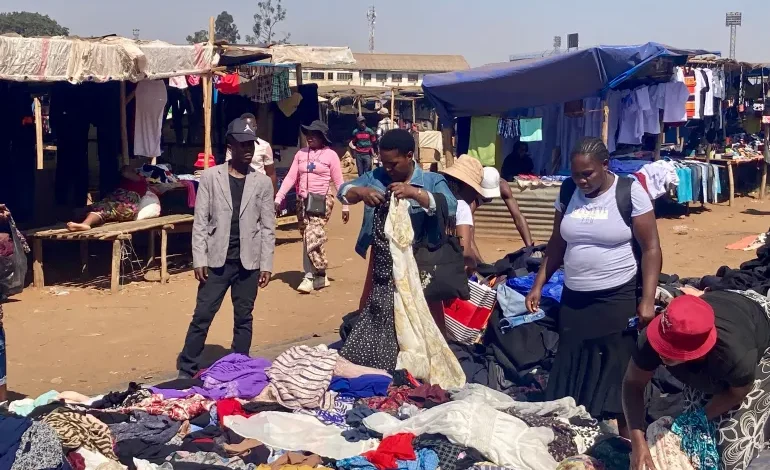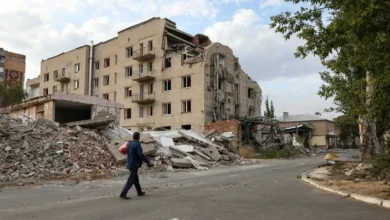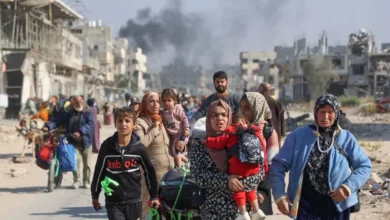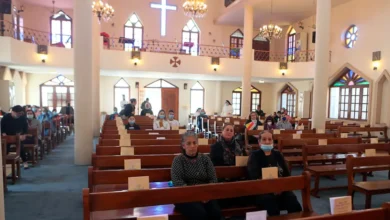How secondhand clothes took Zimbabwe by storm – and hammered retail

Kimberley Dube takes great care with her appearance. She always looks sharp and fashionable in smart-looking jeans, t-shirts, sweatpants, tops, and designer sneakers.
“I love jeans – can’t get enough of them,” the 35-year-old says.
But while she may give the appearance of someone with money to spend on expensive apparel, the self-employed entrepreneur laughs when she says, “You are wrong! These clothes are inexpensive; I get them from secondhand clothes sellers.”
Dube, who lives in Harare, is just one of a multitude of Zimbabweans who have turned their backs on home-grown fashion brands, opting for the booming market in secondhand – or “pre-loved” – imports from overseas instead.
“There’s no shop in this country where you can pay as little as $2 for a pair of jeans,” she scoffs.
“Here” is a small market next door to a suburban shopping centre in a middle-class neighbourhood, where we are perusing the wares. Dube’s equally trendy friend and fellow millennial, Gamuchirai Mpofu, a huge fan of preloved clothes, has also come along.
“The nice thing about shopping here is that though the clothes are used, they are durable, unlike the Chinese stuff sold in most shops,” she says. Both of them say buying used clothes gives them access to a variety of brands and items they can’t find in Zimbabwean shops. “It’s about uniqueness and individuality,” Mpofu says.
Imported used clothing sold in Zimbabwe is, according to the authorities, brought into the country illegally through the porous borders or official border posts with the collusion of customs, immigration and law enforcement officials after it is brought off ships from Europe and North America.
While it is possible to apply for a licence to bring used clothes into the country for re-sale, nobody does this as it is expensive and the import duties are high.
Mutsokoti buys her stock from a “runner”, who in turn buys his stock in Zambia. She pays on delivery so she doesn’t risk losing her money if the runner gets arrested and the clothes are impounded. She pays anything from $150 to more than $250 for a bale of clothes, depending on the quality of the content. “One has a choice as the bales are graded and labelled accordingly.”
Pile ‘em high, sell ‘em low
In another part of the city, the sprawling markets are busy in Mbare, a poorer, working-class neighbourhood and Harare’s oldest Black residential area, known as Harare African Township during colonial times.
Most of the houses in the oldest parts of Mbare have fallen into disrepair. The hostels, which were home to single men who worked in white-owned factories during colonial times and now house families, are in need of refurbishment or demolition, but nothing has been done about them yet.
In one of the markets here, spread out in a dusty open space between the hostels, business in secondhand clothing is brisk.
Most of the selling takes place in makeshift sheds covered with plastic sheeting, with some clothes laid out on tables or displayed on hangers. Mostly, sellers pile the clothes on plastic sheets on the ground.
Prosper Matenga, the owner of a pile of men’s and women’s clothing, keeps a close eye as prospective customers rummage through it, some of them trying on dresses out in the open. His prices range from $3 to $10 depending on what a customer wants to buy and its quality.
He tells Al Jazeera he has been trading in secondhand clothes, also imported via a runner from overseas, since 2018. “I couldn’t find a job, so I tried this. I am happy I did because I can look after my wife and child,” he says. Like Mutsokoti, his stock also comes from overseas.
Matenga says he makes more than a lot of people in formal employment. ”In the early days of winter, I sometimes made as much as $1,000 a day; now, it’s down to around $200, but I am not complaining; I love being my own boss.” By comparison, in Zimbabwe, civil servants earn about $350 a month.
The low overheads are also attractive: “I don’t pay the city council to sell here; I just pay the guy who cleans this space $2 per day and $20 per week for overnight storage.” He shrugs off the notion of paying any sort of vendor fee – mandatory for most legitimate businesses – to the city council with a smile. None of the street vendors selling from downtown Harare’s pavements, outside their homes or from the backs of their trucks or cars, pay a vendor fee.
Prices here are not dissimilar to Mutsokoti’s and those charged by other vendors in the more middle-class areas. However, the Mbare market generally offers more bargains and the emphasis is on durability rather than fashion. Shouts of “Dollar for two” ring across the market; some use bullhorns to attract the attention of potential customers.
Others have different priorities, however. Odera Moyo, in his late 20s, is shopping for clothes at the Mbare market today but draws a line at secondhand clothes for his child. “It’s OK for me and my wife to wear used clothes, but I’ll always buy new stuff for my baby boy,” he says.
Moyo completed high school nine years ago but has never been employed formally since then. “I’d love to have a salary, but jobs are difficult to find because of our country’s economic situation.”
Zimbabwe has been facing economic challenges, including high unemployment rates and inflation for more than 20 years, causing a cost of living crisis for many people. Moyo depends on odd menial jobs and sometimes buys clothing from the market when the prices fall in order to resell them on the street in areas where there are no secondhand clothes markets. “I watch the prices come down to sometimes a dollar for four items and then buy,” he explains.










